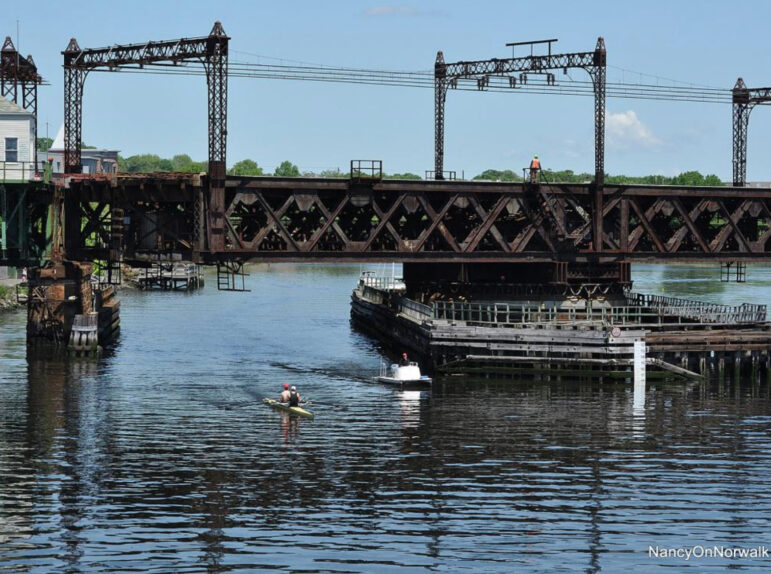By Jim Cameron
Imagine having to replace the George Washington Bridge, in-place, while still handling thousands of cars and trucks each day. The railroad equivalent of that is still underway in South Norwalk, replacing what’s known as the Walk Bridge, a vital rail link in the Northeast Corridor for Metro-North, Amtrak and the occasional freight train.

We all remember the woes of this 125-year-old swing bridge that sometimes refuses to close, stranding thousands of riders. The 2017 plan to replace it includes $161 million in Federal Sandy relief money. But the total cost has ballooned from $600 million to over $1 billion (thanks to added rail yards and such) and again seems to be climbing…and the old bridge is still there.
Some skeptics in Norwalk opposed the plan because of the cost, others because they would lose their land by eminent domain. And everyone’s concerned about the years of construction and mess… including demolition of the Maritime Aquarium IMAX Theater.
The CDOT had considered all sorts of new bridge designs… truss, lift, bascule, counter-weight and even an elevated fly-over. But one design seemed conspicuously missing that might have be cheaper… a non-movable, “fixed” bridge.
Why not just “close the river” and replace the old bridge with a cheaper bridge that doesn’t have to swing or lift open because it’s permanently closed? That option was not even discussed in the voluminous Environmental Assessment Report.
Why?
Blame the US Coast Guard and Army Corps of Engineers. They want to keep the mighty Norwalk River, all two miles of it, open and navigable. But do they really have that much power? Isn’t it possible to force those Federal agencies to, in effect, close the river to boat and barge traffic by edict or a bill put through Congress?
Couldn’t the few companies still on the river… a concrete company, an idle asphalt plant and a small marina… be bought-out with money saved by building a cheaper fixed bridge that doesn’t raise or lower? The answer is yes, but it wasn’t considered, and here’s why.
Six years ago I cornered then-CDOT Commissioner Jim Redeker and asked him.
(Spoiler alert: critics of the bridge plan won’t like his answers.) The Commissioner said that CDOT did ask the US Coast Guard and Army Corps of Engineers about a fixed bridge that would close the river and were told “no way”… though critics say such concessions have precedents elsewhere in the country.
I even asked a member of our Congressional delegation about introducing a bill to “close” the river. He said he could do that, but nobody official has requested that.
More important, then-Commissioner Redeker said whether fixed bridge or movable, construction would still disrupt the neighbors just as much and for just as long. And, said Redeker, the cost savings for going to a smaller, simpler fixed bridge would only be 10 – 12%. Really? Hard to believe.
The Walk Bridge project is worth watching because it may act as a template for other “billion dollar bridge” replacements farther east in the years to come. Everyone just wishes, five years after it started, they’d get on with replacing that old bridge and keeping trains running.
JIM CAMERON has lived in Darien for over 25 years. He serves on the Darien RTM and is Program Director of Darien TV79. He served 19 years on the CT Metro-North Rail Commuter Council, four as its Chairman. In 2014 he founded a new advocacy group, The Commuter Action Group which speaks on behalf of Metro-North riders. His newspaper column “Talking Transportation” archives can be found at http://talkingtransportation.blogspot.com/